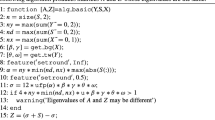Abstract
Let ann xn matrixA of floating-point numbers in some format be given. Denote the relative rounding error unit of the given format by eps. AssumeA to be extremely ill-conditioned, that is cond(A) ≫ eps−1. In about 1984 I developed an algorithm to calculate an approximate inverse ofA solely using the given floating-point format. The key is a multiplicative correction rather than a Newton-type additive correction. I did not publish it because of lack of analysis. Recently, in [9] a modification of the algorithm was analyzed. The present paper has two purposes. The first is to present reasoning how and why the original algorithm works. The second is to discuss a quite unexpected feature of floating-point computations, namely, that an approximate inverse of an extraordinary ill-conditioned matrix still contains a lot of useful information. We will demonstrate this by inverting a matrix with condition number beyond 10300 solely using double precision. This is a workout of the invited talk at the SCAN meeting 2006 in Duisburg.
Similar content being viewed by others
References
T. Dekker, A floating-point technique for extending the available precision. Numerische Mathematik,18 (1971), 224–242.
N. Higham, Accuracy and Stability of Numerical Algorithms, 2nd edition. SIAM Publications, Philadelphia, 2002.
ANSI/IEEE 754-2008: IEEE Standard for Floating-Point Arithmetic. New York, 2008.
D. Knuth, The Art of Computer Programming: Seminumerical Algorithms, Vol. 2. Addison Wesley, Reading, Massachusetts, 2004.
MATLAB User’s Guide, Version 7. The Math Works Inc., 2004.
T. Nishi, T. Ogita, S. Oishi and S. Rump, A method for the generation of a class of ill-conditioned matrices. 2008 International Symposium on Nonlinear Theory and Its Applications, NOLTA ’08, Budapest, Hungary, September 7–10, 2008, 53–56.
T. Ogita, S. Rump and S. Oishi, Accurate sum and dot product. SIAM Journal on Scientific Computing (SISC),26 (2005), 1955–1988.
T. Ohta, T. Ogita, S. Rump and S. Oishi, Numerical verification method for arbitrarily ill-conditioned linear systems. Transactions on the Japan Society for Industrial and Applied Mathematics (Trans. JSIAM),15 (2005), 269–287.
S. Oishi, K. Tanabe, T. Ogita and S. Rump, Convergence of Rump’s method for inverting arbitrarily ill-conditioned matrices. J. Comput. Appl. Math.,205 (2007), 533–544.
S. Rump, A class of arbitrarily ill-conditioned floating-point matrices. SIAM J. Matrix Anal. Appl. (SIMAX),12 (1991), 645–653.
S. Rump, INTLAB—INTerval LABoratory. Developments in Reliable Computing, T. Csendes (ed.), Kluwer Academic Publishers, Dordrecht, 1999, 77–104.
S. Rump, T. Ogita and S. Oishi, Accurate floating-point summation, part II: Sign,K-fold faithful and rounding to nearest. Accepted for publication in SISC, 2005–2008.
S. Rump, T. Ogita and S. Oishi, Accurate floating-point summation, part I: Faithful rounding. SIAM J. Sci. Comput.,31 (2008), 189–224.
N. Yamanaka, T. Ogita, S. Rump and S. Oishi, A parallel algorithm of accurate dot product. Accepted for publication, 2007.
Author information
Authors and Affiliations
Corresponding author
Additional information
This research was partially supported by Grant-in-Aid for Specially Promoted Research (No. 17002012: Establishment of Verified Numerical Computation) from the Ministry of Education, Science, Sports and Culture of Japan.
About this article
Cite this article
Rump, S.M. Inversion of extremely Ill-conditioned matrices in floating-point. Japan J. Indust. Appl. Math. 26, 249–277 (2009). https://doi.org/10.1007/BF03186534
Received:
Revised:
Issue Date:
DOI: https://doi.org/10.1007/BF03186534




